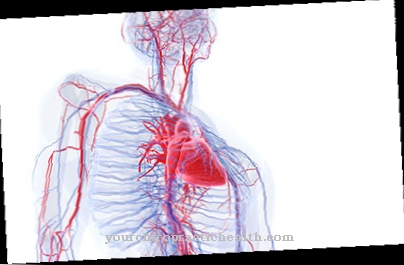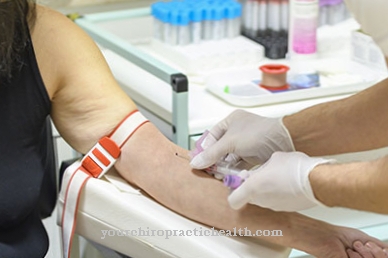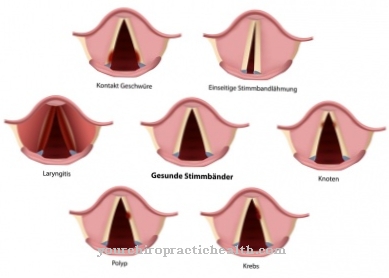Pellagra is a hypovitaminosis caused by a lack of vitamin B3 (niacin). Usually it is the result of malnutrition or malnutrition. However, there is also a genetic form of pellagra called Hartnup's disease.
What is Pellagra?

© bilderzwerg - stock.adobe.com
Pellagra represents an undersupply of the body with vitamin B3 (niacin, nicotinic acid). Today this disease only plays a major role in poor countries with frequent famine and in countries with corn as the main food. Niacin is only found in bound form in maize. Niacin can only be used by the body in alkaline maize. After corn found its way into Europe as a food after the discovery of America by Christopher Columbus, a strange disease spread, the main symptom of which was rough skin.
There were also other physical and psychological symptoms. It has already been suspected that the corn must have something to do with this disease. However, it was speculated whether specific plant toxins or mold infestation could be the cause of this disease. Little knowledge about proper nutrition contributed to the pellagra epidemics occurring in the 18th and 19th centuries.
causes
Pellagra is mainly caused by an undersupply of nicotinic acid in the body. Nicotinic acid, also known as vitamin B3 or niacin, is abundant in meat, liver, fish and whole grain products. Milk and milk products also contain a lot of vitamin B3. In maize or sorghum, niacin is initially in a non-usable form.
It is firmly bound in the molecule and can only be released through alkaline treatment of these foods. In the case of a one-sided diet with untreated maize or sorghum, a deficiency in vitamin B3 occurs. However, niacin can also be synthesized in the body from the amino acid tryptophan.
If the one-sided diet is also associated with a protein deficiency, this also results in a particularly pronounced deficiency of niacin. Niacin is involved in numerous metabolic processes in the body. It plays an important role in generating energy from carbohydrates, fats and proteins. It also participates in the formation of skin, muscle or nerve cells and in the repair of genetic material.
For example, errors in DNA and RNA that occur during cell renewal processes due to a lack of niacin can no longer be adequately corrected. Niacin also improves memory through its influence on the nervous system. Therefore, the lack of niacin causes a complex of symptoms called pellagra.
Symptoms, ailments & signs
Pellagra manifests itself through the appearance of many different symptoms. This is due to the central role that niacin plays in the metabolism. The main symptom is the skin becoming rough. Itching, reddening of the skin, skin thickening, brown discoloration of the skin occurs,
Inflammation of the mucous membrane in the digestive tract and nerve damage. Typical symptoms are diarrhea, dermatitis and dementia. The tongue also turns black. In addition, there are body aches, fatigue, fever, headache, cramps, tremors, paralysis and mental disorders.
In severe cases, the disease can lead to death within weeks. Often, a niacin deficiency due to a general malnutrition is also linked to a deficiency in other vitamins. Therefore, in addition to the typical symptoms of pellagra, there are often other symptoms.
Diagnosis & course of disease
Since pellagra is extremely rare in Europe today, the diagnosis is not made in the majority of cases, despite typical symptoms. Many diseases can have similar symptoms. Only in connection with a conspicuous malnutrition, such as anorexia, can these symptoms lead to the suspicion of a niacin deficiency.
This suspicion should be confirmed by a determination of niacin and its breakdown products in the urine. However, there is also a genetic metabolic disease, which is characterized by an extreme lack of niacin. This is what is known as Hartnup's disease. If pellagra-like symptoms occur without a diet-related cause, a urinalysis should determine the amino acid concentration.
Because Hartnup's disease is characterized by the body's inability to hold back the amino acids from degraded proteins in the blood, there is a high concentration of amino acids in the urine. A genetic analysis can confirm the diagnosis.
Complications
A deficiency in vitamin B3 is initially noticeable through rough skin, itching, and reddening or browning of the skin. Since a vitamin deficiency is practically non-existent in the western world, pellagra is often not diagnosed even if all the typical symptoms are present. If the vitamin deficit is not corrected, a number of complications can arise.
Often, inflammation of the mucous membranes occurs in the digestive tract. The general performance decreases. The sufferer develops symptoms that are also typical of a cold. In particular, he suffers from fatigue, headaches and fever. The skin deteriorates noticeably. Dental health also suffers from a persistent lack of vitamins.
The gums in particular become extremely inflamed and the patient develops severe gingivitis, which can lead to tooth loss. At an advanced stage, damage to the nerves and the brain occurs. The patient can no longer concentrate, the memory constantly deteriorates. In extreme cases, dementia develops.
If the underlying disease still remains undetected, there is an acute danger to life for the person affected. This is especially true if the pellagra is due to malnutrition, for example due to anorexia, since these patients usually also have other nutritional deficiencies and a weakened immune system.
When should you go to the doctor?
Symptoms such as headaches, intestinal disorders or cramps should be clarified quickly by a doctor, as they indicate pellagra or another disease that is triggered by a vitamin and nutrient deficiency. A visit to a doctor is recommended at the latest with skin changes, inflammation of the mucous membranes and neurological complaints. If left untreated, pellagra can lead to diseases such as dementia or dermatitis, or even death. Pellagra is particularly common in people who have a one-sided diet and in particular eat maize or millet. The genetic defect underlying Hartnup's disease can also be the cause of the disease.
High-risk patients such as people who fast regularly or who have a one-sided diet due to a mental illness should consult their family doctor if they suspect a secondary illness. If other risk factors are present, a doctor should be consulted quickly if the symptoms are mentioned. The first point of contact are the family doctor, gastroenterologist and dermatologist if skin complaints are symptoms. The routine examinations can be carried out by a general practitioner. Any injections are usually given as an inpatient.
Treatment & Therapy
Treatment for pellagra is simple. The niacin deficiency can be compensated for by a diet that includes meat, fish, liver, whole grains or dairy products. If there is an extreme niacin deficiency, nicotinic acid can also be administered initially. Brewer's yeast is also well suited to remedy the vitamin deficiency. The nicotinic acid deficiency is often treated with additional doses of tryptophan.
If the niacin deficiency is genetic, as in Hartnup's disease, substitution therapy with nicotinamide is carried out. The state of health usually improves. Sometimes, however, the substitution has no effect. However, since nicotinamide is liver toxic, niacin should be used in large doses. The subsequent red coloration of the skin disappears after a few weeks of treatment.
In parallel with substitution, a high protein diet with dairy products, poultry, beef, nuts and potatoes is recommended. In contrast to the classic pellagra, this diet rich in protein and tryptophan should be maintained for life in Hartnup's disease.
Outlook & forecast
The disease called pellagra, which is based on a chronic niacin or vitamin deficiency, should in itself be eradicated by a sufficient supply of fruit and vegetables. But the abundance of corresponding foods only benefits economically highly developed countries.
Climate change ensures that more and more parts of the world go into disuse. Other parts of the planet are increasingly threatened by flooding. Both of these aggravate the nutritional situation - and thus the pellagra cannot be made to disappear. The global economic and ecological prognosis is just as important here as the health one.
Survival when a pellagra occurs depends crucially on whether treatment is given immediately or not. In addition, the duration and severity of the niacin deficiency determine whether the pellagra can still be treated successfully. If the general state of health is still robust and the age of those affected is not too old, pellagra can often be treated successfully.
On the other hand, the prognosis is poor if treatment is not given promptly. The worse it is for the other parameters mentioned above, the worse the prospect of a complete cure. Since medical care is far from good in many regions of the world affected by Pellagra, many deaths have been recorded from Pellagra.
prevention
Pellagra is very rare in Europe because the diet contains sufficient niacin. To prevent this disease, however, an extremely one-sided and low-protein diet should be avoided. Since Pellagra now mainly arises as part of a pathological anorexia, it is important to recognize and treat the causes of this eating disorder.
Aftercare
The best way to prevent pellagra from occurring is to eat a varied diet. People should avoid one-sided ingestion of corn and millet products. Instead, it makes sense to consume eggs, peanuts and meat. They contain nicotinic acid. This self-responsible aftercare usually ensures that typical complaints subside.
As part of a slight progression, the doctor imparts the relevant knowledge to his patient. As a result, no further complications should arise. Pellagra can also be caused by a genetic defect. Permanent follow-up is then necessary because the symptoms can recur. Diet is required. The patient begins therapy with nicotinic acid or nicotinamide.
Depending on the severity of the complaints, the doctor and patient make an appointment for a check-up. These are used to discuss the current situation. A physical examination and an analysis of the blood and urine allow conclusions to be drawn about the current state. Pellagra arouses the suspicion of deliberate malnutrition, especially in Europe, such as occurs in anorexia.
Because with a normal diet, the disease should not set in. If such a suspicion is confirmed, psychotherapy may be indicated. The success of the aftercare depends heavily on the extent to which the patient is willing to deviate from a certain ideal of beauty.
You can do that yourself
Pellagra is a vitamin B3 deficiency disease that is caused solely by a deficiency in vitamin B3 (niacin). In the advanced stage, a direct supply of niacin in the form of nicotinic acid or nicotinamide is necessary. If the vitamin deficiency was not caused by malnutrition but by impaired absorption capacity of the small intestine, intravenous administration is recommended instead of oral administration.
If the disease is less pronounced, there are everyday and self-help measures in the consumption of foods with a high content of niacin. For non-vegetarians, meat and offal from pork and beef as well as salmon and herring as well as dairy products and egg dishes are recommended. The advantage of vitamin B3, which is derived from animal products, is that it is easily absorbed, because niacin is usually in the easily usable form of nicotinamide. But nature also has foods with a high vitamin B3 content in store for vegetarians and even vegans. These are different whole grain types, walnuts, peanuts and dried apricots. The freshwater alga Spirulina platensis is a food with a particularly large amount of vitamin B3.
If the vitamin deficiency is due to a disturbed absorption capacity in the small intestine, it should be checked whether the deficiency is caused by the intake of certain medications or by a chronic inflammation of the intestinal mucosa or by chronic excessive alcohol consumption.

.jpg)











.jpg)

.jpg)
.jpg)











.jpg)